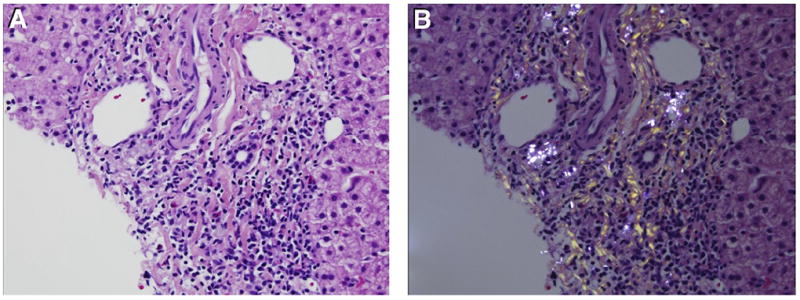Question
A 58-year-old woman presented for treatment of chronic hepatitis C. She was previously treated in 2007, with peginterferon alfa-2b and ribavirin, and was a nonresponder to therapy. Her symptoms included fatigue, joint pains, and generalized pruritis. In review of possible risk factors for acquisition of hepatitis C, the patient stated that she was the recipient of an “accidental” needle stick at the age of 11 while admitted for a surgical procedure. Other risk factors included exploratory laparoscopy approximately 20 years ago for difficulty with conception, 3 left foot surgeries, and 2 cesarean sections. She denied any history of blood transfusions or illicit drug use. Laboratory examination revealed the following: alanine aminotransferase, 30; aspartate aminotransferase, 31; platelets, 212; albumin, 4.4; prothrombin time, 12.8; and hepatitis C RNA, 6,780,000 IU/mL. She had undergone a percutaneous liver biopsy in 2007, which was obtained for review (Figure A and B). What is the most likely route of acquisition of this patient’s chronic hepatitis C?
Figure.


Answer to the Clinical Challenges and Images in GI Question: Talc in the Liver
The histopathology slides obtained from the patient’s liver biopsy in 2007 were reviewed. Figure C identifies a portal region of the biopsy, which shows portal veins, an artery, ducts, and portal inflammation, consistent with chronic hepatitis C infection. However, further investigation of the same region under polarized light (Figure D) reveals 2 important findings, namely, a yellow birefringence consistent with collagen and a white birefringence consistent with talc.
Talc, otherwise known as hydrous magnesium silicate, and is an insoluble crystalline substance.1 In the liver, it appears as white birefringent particles that are elongated with sharp edges, a needle-like shape, and often found lying in small clumps.2 Its identification in liver histology is indicative of injection of recreational drugs because injection drug users often create a suspension of drugs that were initially intended for oral ingestion that contain talc as a tablet filler.1,3 When recreational drugs containing talc are injected intravenously, they are most commonly identified in pulmonary pathology; however, some may escape via arteriovenous pulmonary shunts or via right-to-left cardiac shunts and have been found in other regions of the body.3 In a large autopsy study of 273 drug addicts, birefringent magnesium silicate was identified in the liver in 103 (38%) of the cases.2
The diagnosis of talc within the liver is most easily made via polarized light microscopy, although other possible modalities include that of electron microscopy or x-ray diffraction analysis.3 The clinical utility, as in this case, is in aiding the identification of a causative factor for the acquisition of viral hepatitis when one is not readily identified, as in 16%–35% of cases of chronic hepatitis C.1
Acknowledgments
Supported by the Intramural Research Programs of the NIDDK, NCI, NIH.
Footnotes
See the Gastroenterology web site (www.gastrojournal.org) for more information on submitting your favorite image to Clinical Challenges and Images in GI.
Conflicts of interest
The authors disclose no conflicts.
Contributor Information
Christopher Koh, Liver Diseases Branch, National Institute of Diabetes & Digestive & Kidney, Diseases (NIDDK).
David E. Kleiner, Laboratory of Pathology, National Cancer Institute.
Theo Heller, Liver Diseases Branch, National Institute of Diabetes & Digestive & Kidney, Diseases (NIDDK), National Institutes of Health, Bethesda, Maryland.
References
- 1.Sherman KE, Lewey SM, Goodman ZD. Talc in the liver of patients with chronic hepatitis C infection. Am J Gastroenterol. 1995;90:2164–2166. [PubMed] [Google Scholar]
- 2.Kringsholm B, Christoffersen P. Liver pathology in fatal drug addiction. Forensic Sci Int. 1982;20:141–151. doi: 10.1016/0379-0738(82)90139-6. [DOI] [PubMed] [Google Scholar]
- 3.Molos MA, Litton N, Schubert TT. Talc liver. J Clin Gastroenterol. 1987;9:198–203. doi: 10.1097/00004836-198704000-00018. [DOI] [PubMed] [Google Scholar]


